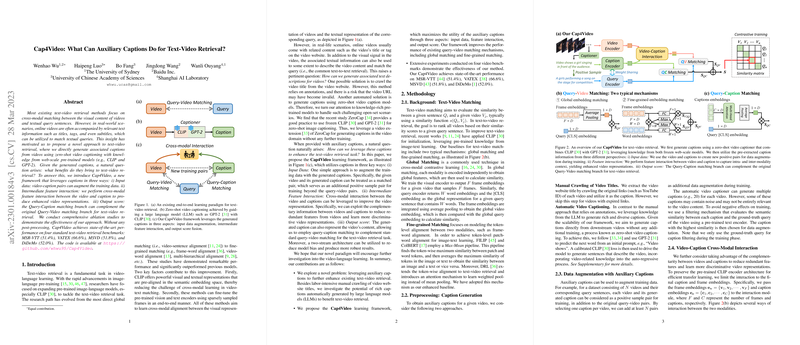An Overview of Cap4Video: Enhancing Text-Video Retrieval through Auxiliary Captions
The paper, "Cap4Video: What Can Auxiliary Captions Do for Text-Video Retrieval?" by Wu et al., introduces Cap4Video, a novel framework for improving text-video retrieval by incorporating auxiliary captions. In a landscape where most existing methods focus on cross-modal matching between video content and textual queries, Cap4Video explores the untapped potential of using captions generated from pre-trained LLMs to enhance retrieval accuracy. This framework integrates auxiliary captions into the text-video retrieval process through data augmentation, feature interaction, and score fusion, yielding state-of-the-art performance on several benchmarks.
Core Contributions and Methodology
The authors identify a vital gap in current text-video retrieval algorithms, which is the inefficient use of textual content naturally accompanying many videos, such as titles and descriptions. Cap4Video harnesses this potential by utilizing zero-shot video captioning techniques leveraging models like CLIP and GPT-2. The paper explores three main avenues through which these auxiliary captions can contribute to better retrieval performance:
- Data Augmentation: Cap4Video uses video-caption pairs to augment the training data. This approach introduces additional positive training samples alongside conventional query-video pairs, thereby broadening the training dataset and enhancing the robustness of the retrieval model.
- Feature Interaction: The framework introduces a mechanism for cross-modal feature interaction between videos and their generated captions. This interaction aims to improve video representations by reducing feature redundancy and emphasizing discriminative features, which is achieved through various methods such as the Cross Transformer and Co-attention Transformer strategies.
- Output Score Fusion: By employing a Query-Caption matching branch alongside the traditional Query-Video branch, Cap4Video enhances the query-video retrieval process. This dual-branch approach facilitates a more robust retrieval mechanism that capitalizes on both video content and auxiliary textual cues.
Numerical Results and Performance
Cap4Video's performance is validated on four major text-video retrieval benchmarks: MSR-VTT, VATEX, MSVD, and DiDeMo. The framework achieves state-of-the-art results, notably improving R@1 scores across all datasets. For instance, it records a R@1 score of 51.4% on MSR-VTT and 66.6% on VATEX. Such results are attributed to the comprehensive integration of auxiliary captions into various stages of the retrieval pipeline, offering substantial accuracy gains without complex post-processing.
Theoretical and Practical Implications
The research presents several implications for both the theoretical understanding and the practical application of video-language learning. From a theoretical perspective, the work exemplifies the benefits of using auxiliary information derived from non-visual content associated with videos, challenging the community to rethink conventional cross-modal retrieval paradigms. Practically, Cap4Video offers a scalable and efficient pathway to enhance retrieval systems, pointing towards broader applications in video recommendation systems, content retrieval, and multimedia search engines.
Prospects for Future Research
The promising results of Cap4Video open avenues for further research. One potential area is exploring the generalization of this framework to other modalities and embedding larger datasets during training to evaluate scalability. Additionally, enhancing the zero-shot capability of video captioning models such as ZeroCap by integrating them with newer LLMs could yield even richer captions, increasing retrieval efficacy. Researchers may also consider fine-tuning pre-trained models specifically for video contexts, potentially combining them with domain-specific knowledge to improve caption accuracy.
In conclusion, Wu et al.'s Cap4Video represents a significant step forward in text-video retrieval. Its multi-faceted use of auxiliary captions not only enhances retrieval accuracy but also provides a new lens through which future work can approach the integration of multi-modal information. This paper forms a bridge between traditional retrieval methods and emerging techniques powered by large-scale pre-trained models, setting a benchmark for subsequent innovations in the field.
